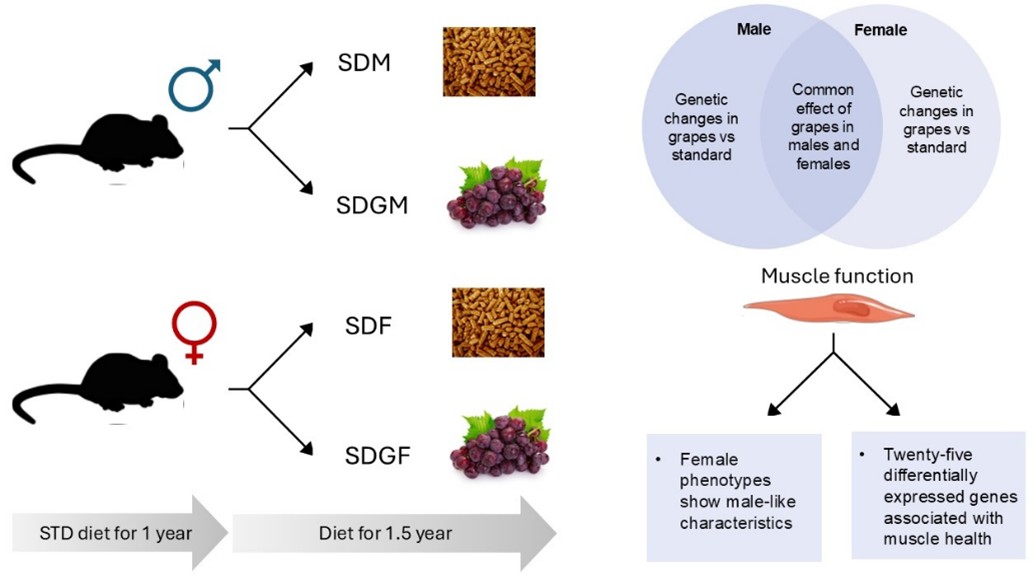
Long-Term Grape Consumption Can Improve Muscle Health
The preoccupation with health and wellness continues to grow and diversify, manifesting as popular trends and areas. Maintaining healthy muscle mass and strength is gaining in popularity; this is partly due to increased awareness of the benefits of healthy muscle mass and strength, especially in healthy ageing.
There are over 600 skeletal muscles throughout the human body they are needed for movement and a wide range of other mechanisms, including digestion and cardiac function.
Loss of muscle mass happens gradually as we age. Sarcopenia is a progressive loss of muscle mass and function, which affects 10–16% of elderly people globally. Actively working on improving and maintaining muscle mass and strengthening through regular exercise and diet can prevent the onset of sarcopenia.
Researchers from the US recently published an article in the Open Access journal Foods, which investigated the nutrigenomics of grapes and the long-term benefits on muscle health from long-term grape consumption.
Nutrigenomics and grapes
Nutrigenomics is defined by the National Cancer Institute (NCI) as:
The study of how food affects a person’s genes and how a person’s genes affect the way the body responds to food.
Nutrigenomics can be used to investigate how genes and diet together may affect a person’s health and risk of developing certain diseases. Moreover, it can also be used to prevent and treat disease.
Grapes are known to contain over 1600 phytochemicals, naturally occurring plant-derived compounds with health benefits such as antioxidant and anti-inflammatory properties. It is suggested that they exhibit potential disease-preventative properties via nutrigenomic mechanisms rather than direct chemical interaction. Moreover, individual phytochemicals, including resveratrol, quercetin and catechins, commonly found in red grapes and grape skin, are associated with beneficial effects on skeletal muscle health.
The researchers from the US investigated the nutrigenomic effect that long-term grape consumption had at the molecular level in the skeletal muscles of male and female mice over 2.5 years. Additionally, they also monitored differences in nutrigenomic effects between male and female mice.
Analysing the nutrigenomics of grapes in mice
The researchers used mouse models to analyse the nutrigenomic effect of long-term grape consumption.
They split the mice by sex; each group contained 240 mice, which were fed a 4% fat standard diet (SD) for the first year of the study. After 1 year, the mice were split into four groups, each containing 120 mice: males fed with SD, females fed with SD, males fed with SD with added grape powder (SDGM), and females fed with SD with added grape powder (SDGF). After 1.5 years of consuming the above diets, the researchers randomly selected five mice from the SDM, SDF, SDGM and the SDGF groups for analysis.
The mice were analysed following 1.5 years of the study, as the mice were 2.5 years of age during this time. This period in a mouse’s lifespan approximates a human’s equivalent age of 80 years.
Before analysis, the researchers measured the body weight of the selected mice and then collected tissue samples. The researchers then analysed the muscles using histological methods. They also extracted and sequenced the mice’s RNA and interpreted the results using pathway and gene ontology enrichment analysis. Moreover, the researchers also produced a heatmap to help visualise and interpret the gene expression results. The researchers then conducted principal component analysis and differential expression analysis. Finally, the researchers established statistical significance using a range of statistical analysis tools.

Source: https://www.mdpi.com/2304-8158/14/4/695#
“This study provides compelling evidence that grapes have the potential to enhance muscle health at the genetic level. Given their safety profile and widespread availability, it will be exciting to explore how quickly these changes can be observed in human trials.” – Dr John Pezzuto, senior investigator of the study
Grapes can maintain muscle health
The researchers identified twenty-five differentially expressed genes associated with muscle health. Moreover, the researchers identified that daily grape consumption significantly alters muscle gene expression. This included the upregulation of genes associated with lean muscle mass such as Ahsg, Alb, Apoa1, and Arg1, as well as the downregulation of genes associated with muscle degeneration, including Camp, Lcn2, and Irf4, which suggested improved muscle function. Additionally, the researchers identified that muscle gene expression had a more pronounced effect on female mice. This study demonstrates the potential of nutrigenomics in understanding dietary influences on gene expression and sex-specific responses.
The researchers note that further studies and clinical trials are needed to confirm human applicability and the physiological implications of this research.
If you would like to read more or submit research about nutraceuticals and functional foods, please see the Open Access journal Foods, section Nutraceuticals, Functional Foods, and Novel Foods.










